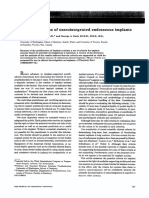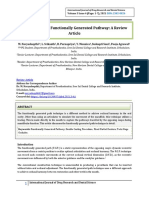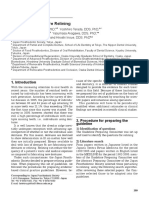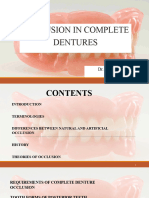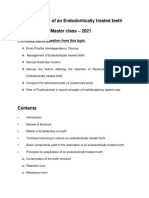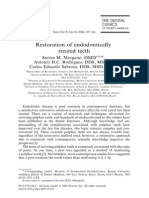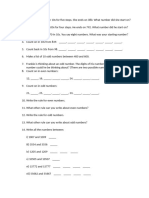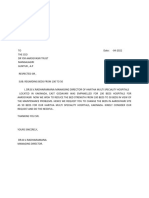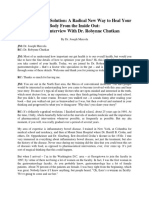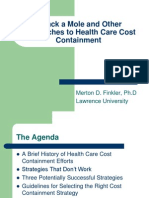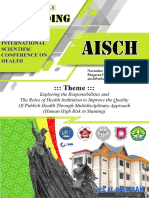Abutment Evaluation in FPD 2
Abutment Evaluation in FPD 2
Uploaded by
ahmad955mlsCopyright:
Available Formats
Abutment Evaluation in FPD 2
Abutment Evaluation in FPD 2
Uploaded by
ahmad955mlsCopyright
Available Formats
Share this document
Did you find this document useful?
Is this content inappropriate?
Copyright:
Available Formats
Abutment Evaluation in FPD 2
Abutment Evaluation in FPD 2
Uploaded by
ahmad955mlsCopyright:
Available Formats
Journal of Dental Herald
www.dherald.in Journal of Dental Herald
(April 2014) Issue:2, Vol.:1
E ISSN No. : 2348 – 1331
P ISSN No. : 2348 – 134X
A Review
Abutment Evaluation – A Boon To Success Of Fixed Partial Denture
Sharma Sumeet1, Sethuraman Rajesh2, Singh Harvinder3, Singh Sarbjeet4, Wazir Dev Nikhil5
1
Senior lecturer, Department of Prosthodontics, Institute of Dental Sciences, Sehora, Jammu, India.
2
Professor, Department of Prosthodontics, K.M. Shah Dental College & Hospital, Vadodara, India.
3
Professor, Department of Prosthodontics,Institute of Dental Sciences, Sehora, Jammu, India.
4
Reader, Department of Oral Medicine & Radiology, Institute of Dental Sciences, Sehora, Jammu, India.
5
Professor & HOD, Department of Conservative & Endodontic, Institute of Dental Sciences, Sehora, Jammu, India.
Abstract
Fixed partial dentures transmit forces through the abutments to the periodontium. Failures are due to poor engineering, the use of improper
materials, inadequate tooth preparation, and faculty fabrication. Of particular concern to dentists is the selection of teeth for abutment. They must
recognize the force developed by the oral mechanism, and the resistance of the tooth and its supporting structures to them.
Successful selection of abutments for fixed partial dentures requires sensitive diagnostic ability. Through knowledge of anatomy, ceramics, the
chemistry and physics of dental materials, metallurgy, periodontics, phonetics, physiology, radiology and the mechanics of oral function is
fundamental1. This article review diagnostic procedures and requisities for the selection of abutments.
Key Words
Biomechanics, FPD, Pontics, Retainer, Span length, Clinical crown, Anatomical crown.
Introduction double as an FPD retainer. If several abutments in one arch
Fixed prosthodontic treatment can range from the restoration require crowns, there is a strong argument for the selection of a
of a single tooth to the rehabilitation of the entire occlusion. fixed partial denture rather than a removable partial denture[1].
Single teeth can be restored to full function, and improvement
in cosmetic effect can be achieved. Missing teeth can be Diagnostic Casts
replaced with prostheses that will improve patient comfort and Accurate diagnostic cast must be correctly oriented to the
masticatory efficiency, maintain the health and integrity of the transverse hinge axis and the plane of occlusion on an
dental arches, and, in many instances, elevates the patient’s articulator to permit eccentric movements similar to those that
self-image. take place in the mouth. This procedure allows a simple
Every restoration must be able to withstand the constant evaluation of the occlusal relationships of the dental arches and
occlusal forces to which it is subjected. This is to particular the abutment teeth.
significance when designing and fabricating a fixed partial
denture, since the forces that would normally be absorbed by Roentgenographic Examination
the missing tooth are transmitted, through the pontic, Periapical and bite-wing films are most important in selection
connectors and retainers, to the abutment teeth. For example, of abutment teeth. The primary purpose of roentgenograms is
to evaluate the significance of a simple full crown on a to disclose hidden areas and structures such as the root
mandibular molar tooth in a patient with relatively normal morphology, pulp outline, the periodontal ligament space, the
occlusion, a full complement of teeth and normal bone support. alveolar bone, infrabony defects, residual roots, impacted or
We see that the following parameter of form and forces are supernumerary teeth, and the extent of present or past caries.
within the control and responsibility of the operator: Definite rules of treatment planning cannot be formulated.
a) Number and area of occlusal contacts. However, an understanding of the favourable indications and
b) Inclination and length of cusps. reasonable limitations of abutments for fixed partial dentures
c) Axial contours. is essential[2].
Abutment teeth are called upon to withstand the forces Factors Governing Abutment Selection
normally directed to the missing teeth, in addition to those Crown
usually applied to the abutments. Gottlieb has suggested a special terminology, anatomic crown
If a tooth adjacent to an edentulous space needs a crown and clinical crown. He calls the enamel covered portion of the
because of damage to the tooth, the restoration usually can tooth the anatomic crown, and the cementum covered portion,
the anatomic root. Clinically, that portion of the tooth which is
Quick Response Code Address For Correspondence: actually erupted (exposed) is called the clinical crown, and the
Dr. Sumeet Sharma, remainder of the tooth, which is still united with the investing
Senior Lecturer,
Department of Prosthodontics, tissues, the clinical root. Thus, it may be said that in youth the
Institute of Dental Sciences, clinical crown is smaller than the anatomic crown, and in old
Sehora, Jammu, India.
Phone no. 09419148335.
age the clinical crown is greater than the anatomic. In certain
E-mail: drsumit02@gmail.com mouths, all of anatomic crowns are exposed at the age of 40; in
others, at least for some teeth, there is an epithelial attachment
©Journal of Dental Herald (April 2014, Issue:2, Vol.:1). 038
to the enamel at 50 years or even later. these patients the prevalence of root surface caries did not
correlate with the degree of oral hygiene or with evidence of
Size of crown: The combined existing surface area of the previous coronal caries. "These data suggest that the incidence
periodontal ligaments of the abutment teeth should be equal or of root surface caries may be a function of diet rather than an
exceed the normal area of the periodontal ligament of the teeth inevitable sequelae of root exposure. The root surface
to be replaced.[3] The surface area of the periodontal ligaments concavities and increased surface area associated with
of normal teeth has been measured by several investigators.[4],[5] exposed roots also complicate oral hygiene efforts, thus
The total mesio-distal width of the cusps of abutments should favoring an increased incidence of caries. Sensitivity from
equal or exceed the width of the cusps of pontics. exposed root surfaces is also a common problem. A variety of
techniques and substances are available for desensitization."
Occlusal anatomy: Occlusal anatomy has an indirect Unfortunately, no one approach is uniformly successful.
influence on the loads transmitted to the teeth. The occlusal
surfaces of natural posterior teeth have distinct cusps with The early guidelines on crown-to-root ratio for abutment teeth
many primary and supplemental ridges. The cusps are convex were conservative, but they still serve as a standard in many
in both directions with grooves interspersed between the texts.[11] Ante's Law[11] states that "The combined pericemental
rigdes. Stallard[6] points out that worn-down teeth need more area of the abutment teeth should be equal to or greater in
muscular power and longer and more masticatory strokes in pericemental area than the teeth to be replaced." Removal of all
order to chew food enough. Much of this force is directed at teeth or roots that are "unfit" for further service was also
right angles to the long axis of the teeth. recommended.
Buccolingual dimension of the teeth: The occlusal surface of Definition and measurement technique:
the pontics should harmonize with the buccolingual dimension The level of supporting bone is rarely coincident with the
of the natural unmutilated teeth, and recreate the normal buccal cementoenamel junction or dentogingival junction(Fig. 1).
and lingual form to the height of contour. Reducing the width Evaluation is best performed using the clinical crown-to-root
of the pontics does not materially reduces the force transmitted ratio. Further use of the term crown-to-root ratio will refer to
to the abutments, but merely places heavier per unit stress on
the restoration and produces conditions in the pontic.
Roots
The forces acting on a tooth are transferred to the supporting
bone through the root. The shape of the root determines the
ability of the abutment to transfer the masticatory load to the
supporting bone.
a) Number: Multirooted posterior teeth with widely
separated roots will offer better periodontal support than
roots that converge, fuse, and generally present a conical
configuration.
b) Size: Teeth with longer root are stronger abutment than
compared to the shorter ones.
c) Width: Roots with greater labio-lingual width are
preferred.
d) Shape: Roots with irregular curvature are preferred. Teeth
with conical roots can be used for short span fixed partial
dentures.
Crown: root ratio: Poor crown-to-root ratio can result from
improper dental treatment as well as from traumatic or
pathologic changes that either increase the length of the
clinical crown or decrease the length of the clinical root. In
1955, Marshall-Day and associates[7] found crestal loss of
alveolar bone in 98% or more of a sample of individuals 35 Figure 1
years of age or older. In 1962, examination of a random sample
of Americans revealed the increased prevalence of the clinical ratio unless otherwise specified.
periodontitis and advanced tissue destruction associated with Jepsen[5] compared root surface areas and radio-graphic root
older age groups.[8] areas and established that they could be correlated within a
Mobility, as related to crown-to-root ratio, occurs when 10% to 15% margin of error, thereby demonstrating the
alveolar support is no longer adequate to withstand the forces validity of radiographic evaluation. Workers usually
encountered in the oral cavity. Tooth mobility becomes recommend the use of Ante's Law when allowances for a 15%
significant when the re-quirements of comfort and masticatory to 20% variation in computations of the pericemental area are
function are compromised.[9] Development of dental caries on made." Other textbooks proposed the use of actual crown-to-
exposed root surfaces is a potential problem. A recent study root ratio in determining prognosis. Presumably these are
revealed increased amount of caries on exposed root surfaces based on linear measurements from radiographs. A ratio of 1:2
in the mandibular arch, most frequently in premolars.[10] In was considered ideal. 1:1.5 was acceptable, and a crown-to-
©Journal of Dental Herald (April 2014, Issue:2, Vol.:1). 039
root ratio of 1:1 was considered minimal or doubtful.[12],[13] Design of the preparations for cast restorations are dictated by
Crown-to-root ratio was also discussed in terms of the linear the anatomy of the root surfaces, which may necessitate
amount of bone loss although the importance of this approach endodontic therapy.
varies with root form and length. Teeth exhibiting extensive Contours must be consistent with existing root contours and
bone loss, with pocket depth greater than 6 to 7 mm from the clinical crown form to permit essential hygiene.
cementoenamel junction, are sometimes considered hopeless Extraction: Extraction must be considered as a treatment
because of the compromises encountered in periodontal alternative. Removal or retention of molar teeth related to
surgery[13]. Tylman[14] recommended that teeth with a normal furcation involvement was reviewed by Saxe and Carmen.[17]
amount of bone be used for abutments. However, he stated that These considerations also applied to teeth with poor crown-to-
teeth lacking one third to one half of their normal periodontal root ratio.
attachment. Beube[15]," discussing the retention or extraction of
teeth, assigned a poor prognosis to teeth with only one third of These authors suggested that the indications for removal of
the apical bone remaining, advanced mobility, and poor root problem teeth are
morphology. Goldman and Cohen[16]* advocated the retention (1) An unopposed terminal tooth in an arch.
of teeth based on their ability to return to health and maintain (2) A periodontally involved tooth with sound adjacent teeth
themselves in function. providing other treatment alternatives.
(3) A solitary distal abutment that exhibits mobility.
Treatment considerations for teeth with poor crown-root
ratio Periodontal factor
Plaque: Plaque control and adequate oral hygiene are of Inflammation: A diagnosis of periodontitis is not uncommon
primary concern in teeth having poor crown-to-root ratio. for the patient requiring prosthodontics because one or more
Continued progression of periodontitis due to inadequate teeth may already have been lost to periodontal disease.
plaque control invites treatment failure. Examples are the The goals of periodontal therapy for the prosthodontic patient
addition of margins and solder joints and the exposure of less are: to resolve the inflammation; convert periodontal pocket
accessible, concave crown and root surfaces. depths to clinically normal sulcular depths; establish
Periodontal surgery: Periodontal surgery can affect the physiologic gingival architecture; and provide an adequate
crown-to-root ratio. Complete: osseous resection of zone of attached gingiva. Adequate oral hygiene is
periodontal bony defects to create physiologic contours may fundamental to the maintenance of a healthy periodontium.
result in loss of surrounding bone. Selipsky[17]" noted that the If surgical intervention is required to achieve therapeutic
decreased mobility obtained in initial therapy was not goals, approximately six to eight weeks of healing is
compromised in the long-term (1 year) by definitive surgery recommended before the gingival termination of the tooth
within "clinically operable limits.” preparations is completed.
Periodontal support regeneration: Regeneration of lost Furcation invasions: Teeth with furcation invasions require
periodontal support is the most logical approach to improve special consideration.
poor crown-to-root ratio, and bone grafting is the most reliable Margin placement: G.V. Black's original concepts of
method. Ingber[18] presented the rationale and technique of "extension for prevention"[20] have been modified. Broad
forced eruption as a method of treating one- and two-wall extension of cavity preparations to place margins in "caries
infrabony defects. immune" areas is not universally advocated. The
Occlusal reduction: Reducing clinical crown length by recommendation that all gingival finish lines be developed
occlusal reduction of extruded teeth is a valid approach to within the gingival crevice has been challenged.[20],[21]
improving the crown-to-root ratio. Bohannan and Abrams The gingivae are healthiest when margins are placed well
discussed crown shortening in conjunction with intentional above (i.e., 1 to 2 mm) the gingival crest[22], and intracrevicular
pulp extirpation. They noted an improved crown-to-root ratio margin placement is not the universal solution to dental caries.
but encountered complications. For each millimeter of Biologic width: Histologic studies by Gargiulo, et al[23] have
posterior tooth reduction and resultant decrease in the vertical demonstrated a band of soft tissue attach-ment between the
dimension of occlusion, an increase of 3 mm of anterior base of the gingival sulcus and the alveolar crest that is
vertical overlap (overbite) will occur. Overdentures represent composed of approximately 1 mm of junctional epithelium
an extreme approach to crown shortening and crown-to-root (attachment epithelium) and 1 mm of connective tissue fibers.
ratio improvement, providing a new treatment alternative. This dento-gingival attachment, referred to as the "biologic
Increasing stability: The mobility seen in teeth with poor width"[24] (Fig.2), has significant implications in treatment
crown-to-root ratio can be reduced by selectively grinding planning. The presence of caries, fractured root structure, or
occlusal surfaces and minimizing horizontal forces in the previous restorations apical to the gingival crest may-
existing dentition.[9] Teeth which have poor crown-to-root ratio predispose to violation of the biologic width during tooth
and exhibit mobility can be retained through splinting. preparation. A short clinical crown may induce the dentist to
Dawson[19] emphasized the difficulty in maintaining good oral overextend the preparation apically in an attempt to enhance
hygiene in splinted areas and suggested splinting only when it retention.[25]
is needed.
Restorative consideration: Cast restorations for teeth with poor Location in the arch
crown-to-root ratios place greater demands on the dentist. Parfitt GJ (1960), have shown that the faciolingual movement
Ideal margins of restorations are essential, since inflammation ranges between 56-108 µm, and intrusion of 28 µm. Teeth in
has been associated with restorations having excellent different segments of the arch move in different directions.
margins.[19] Because of the curvature of the arch, the faciolingual
©Journal of Dental Herald (April 2014, Issue:2, Vol.:1). 040
Figure 2
movement of an anterior tooth occurs at a considerable angle to
the faciolingual movement of the molar(Fig.3).
Figure 4
ARCH CURVATURE: There is a common problem in quarter down that has been rotated 90 degrees so that the distal
replacing all four maxillary incisors with a fixed partial surface is uncovered. A telescope crown and coping can also be
denture and the problem is more pronounced in the arch that is used al a retainer on the distal abutment.[34] A full crown
pointed in the anterior. This occurs because the pontics lie preparation with heavy reduction is made to follow the long
outside the interabutment axis line and thus acts as a lever arm, axis of the tilted molar. An inner coping it made to fit the tooth
which can produce a torquing movement. In order to offset the preparation, and the proximal half crown that will serve as the
torque, additional retention is obtained in the opposite retainer for the fixed partial denture it fitted over the coping.
direction of the lever arm and at a distance from the
interabutment axis equal to the length of the lever arm. Conclusion
Competent treatment depends upon the careful examination of
The first premolars sometimes are used as secondary all available information, a definitive diagnosis, and a realistic
abutments for a maxillary four-pontic canine to canine fixed treatment plan that offers a favourable prognosis. A
partial denture. Because of the tensile forces that will be comprehensive, sequential approach to treatment planning is
applied to the premolar retainers, they must have excellent essential. Planning for fixed prosthodontics must not be
retention(Fig.3). independent of other disciplines of dentistry. Hasty, segmented
planning that ignores major aspects of needed treatments
defies modern concepts of treating “the whole patient” rather
than individual teeth.
When planning and treating cases involving fixed
prosthodontic restorations, it is important that all the
applicable parameters are taken into account. The
prosthodontist must not focus too much on the finer details of
constructing a “perfect” restoration, or risk creating a failure
because proper engineering principles was not used. If success
is to be attained the prosthodontist must take into account the
Figure 3 length of span, attachment apparatus, periodontal bone loss,
inclination of teeth, position in the arch, opposing occlusion to
examine and comes to a specific treatment planning and one
Angulation must make use of modern diagnostic tools. One such
A common problem that occurs with some frequency is the indispersible tool at the hand of the operator is the radiograph.
mandibular second molar abutment that has tilted mesially into A thorough analysis of the radiograph often reveals that the
the space formerly occupied by the first molar. It is impossible abutment teeth may not satisfy the requirement of Ante’s law.
to prepare the abutment teeth for a fixed partial denture along However, long term studies have proved that treatment
the long axes of the respective teeth and achieve a common regimen & maintainence can convert questionable abutments
path of insertion. There is further complication if the third into ideal abutments.
molar is present. It will usually have drifted and tilted with the Radiographs are made, and pulpal health is assessed by
second molar. Uprighting is best accomplished by the use of a evaluating the response to thermal and electrical stimulation.
fixed appliance.[27] Both premolars and canine are banded and Existing restorations, cavity liners, and residual caries are
tied to a passive stabilizing wire.A helical uprighting spring is removed, and a careful check is made for possible pulpal
inserted into a tube on the banded molar and activated by exposure. Teeth in which pulpal health is doubtful should be
hooking it over the wire on the anterior segment.[27],[28] The endodontically treated before the initiation of fixed
average treatment required is 3 months.[29] A proximal half prosthodontics. Although a direct pulp cap may be an
crown sometimes can be used as a retainer on the distal acceptable risk for a simple amalgam or composite resin,
abutment.(Fig.4)[33] This preparation design is simply a three- conventional endodontic treatment is normally preferred for
©Journal of Dental Herald (April 2014, Issue:2, Vol.:1). 041
cast restorations, especially when the later need for endodontic Philedelphia, 1971, W.B Saunders Co.
treatment would jeopardize the overall success of treatment. 13. Dykema, R.W: Fixed Partial Prosthodontics, J. Tenn Dent
Assoc. 43: 309, 1962.
References 14. Tylman, S.D: Theory and Practice of Crown and Bridge
1. Shillingburg H.T, Hobo Sumiya, Whitsett L.D, Jacobi Prosthodontics, ed.5, st. Louis,1965, The C.V. Mosby
Richard, Brackett S.E. Fundamental of Fixed Company, p- 173.
Prosthodontics, ed. 3, Quintessence Publishing Co, 15. Beube, F.E: Correlation of the degree of alveolar bone loss
Inc.2010. with other factors for determining the removal or retention
2. Johnston J.F., Phillips R.W., Dykema R.W. Modern of teeth. Dent. Clin. North Am. 13: 801,1969.
Practice in Crown and Bridge Prosthodontics, ed. 2, 16. Goldman, H.M, and Cohen, D.W.: Periodontal Therapy,
Philadephiah,1965. W.B. Saunders Company, p. 5. Ed. 5, St. Louis, 1973, C.V. Mosby. Co.
3. Reynold J.M. : Abutment Selection for fixed 17. Prichard, J.F: Advanced Periodontal Disease. Surgical and
Presthodontics J. Prosthet Dent.. 19:483, 1968. Prosthetic Management, ed.2, Philadelphia, 1972, W.B
4. Ante, I.H: J. Canadian D.A. 2: 249-260, 1936. Saunders Co.
5. Jespen, A: Root surface Measurement and A method for X- 18. Robert E. Penny., crown-to-root ratio: its significance in
ray Determination of Root surface area, Acta. Odont. resforative Dentistry, J. Prosthet Dent Vol 42; Number, July
Scandinav. 21: 35-46,1965. 1979.
6. Stallard, H.: The Good Mouth- A syallabus on Oral 19. Dawson PE. Evaluation, Diagnosis and Treatment of
Rehabilitation and Occlusion , University of California, occlusal Problems,ed 1 ST.Louis, 1974.
San Fransisco, Calif., Vol.1, p- 13. 20. Blackwell, R.E. G.V. Black’s operative Dentistry, Vol. II,
7. Marshall-Day, C.D., Stephens, R.G., and Quigley, L.F., Jr.: ed.9, South Milwankee, 1955, Medico-Dental Publishing
Periodontal disease: Prevalence and incidence. J. Co.P-110-111.
Periodontal 26: 185,1955. 21. Reynold J.M.: Abutment Selection for fixed
8. Johnson, E.S., Kelly, J.E., and Vankirk, L.E.: Selected Presthodontics J. Prosthet Dent.. 19:483, 1968.
Dental findings for adults. National center for health. 22. Romanelli, J.H.I. Periodontal considerations in tooth
Statistics, Series 11, No. 7, Washington, D.C, 1965. U.S. preparation for growth and Bridge, Dent Cli. NorthAm.
Public Health Service. 24:2,271-283, 1980.
9. Nyman, S. Lindhe. J, and Lundgren. D.: The role of 23. Marcum, J.S. : The effect of crown marginal depth upon
occlusion for the stability of fixed bridges in patients with gingival tissue, J. Prosthet Dent. 17:2,271-283, 1980.
reduced periodontal tissue support., J. Clin. Periodontal, 2 : 24. Glickman, I.: Clinical Periodontology, ed. 4, Philedelphia,
53, 1975. 1972, W. B. Saunders Co., p- 879-898.
10. Sumney, D.L. Jordon, H.V., and Englander H.V.: The 25. Miller, C.: A Clinical interpretation of tooth preparation
Prevalence of root surface caries in selected population. and design of metal substructures for metal ceramic
J.Periodontal 44: 500, 1973. restorations. In Mclean, J.W., editor; Dental Ceramics,
11. Ante, I.H.: The Fundamental Principles of Abutment, Chicago, 1983, Quintessence Publishing co, Inc., P-169-
Mich. Dent. Soc Bull. 8: 14, 1926. 170.
12. Johnston, J.E, Phillips, R.W., and Dykema, R.W: Modern
Practice in Crown and Bridge Prosthodontics, ed. 3,
Source of Support : Nill, Conflict of Interest : None declared
©Journal of Dental Herald (April 2014, Issue:2, Vol.:1). 042
You might also like
- Criteria For Success of Osseointegrated Endosseous Implants ZarbDocument6 pagesCriteria For Success of Osseointegrated Endosseous Implants ZarbSebastian ScanlonNo ratings yet
- Abutment Selection in Fixed Partial DentureDocument6 pagesAbutment Selection in Fixed Partial DentureheycoolalexNo ratings yet
- Abutment Selection in Fixed Partial Denture - A Review: Drug Invention Today January 2018Document6 pagesAbutment Selection in Fixed Partial Denture - A Review: Drug Invention Today January 2018Najeeb UllahNo ratings yet
- Orthodontically Driven Corticotomy: Tissue Engineering to Enhance Orthodontic and Multidisciplinary TreatmentFrom EverandOrthodontically Driven Corticotomy: Tissue Engineering to Enhance Orthodontic and Multidisciplinary TreatmentFederico BrugnamiNo ratings yet
- Eview: Retentive Aids in Maxillofacial Prosthodontics - A ReviewDocument5 pagesEview: Retentive Aids in Maxillofacial Prosthodontics - A ReviewjoephinNo ratings yet
- What Is A Complete Denture? - My Dental Technology NotesDocument9 pagesWhat Is A Complete Denture? - My Dental Technology NotesRosa GhahremaniNo ratings yet
- An Insight in To Functionally Generated Pathway: A Review ArticleDocument7 pagesAn Insight in To Functionally Generated Pathway: A Review ArticlejancyNo ratings yet
- Minor Connector PDFDocument24 pagesMinor Connector PDFghanim alubeidiNo ratings yet
- Guideline For Denture ReliningDocument8 pagesGuideline For Denture ReliningChintya Monica AmelindaNo ratings yet
- F Methods of Recording Centric Relation FinalDocument17 pagesF Methods of Recording Centric Relation FinalJyoti TripathiNo ratings yet
- Anterior Deprogramming Device Fabrication Using A Thermoplastic Material PDFDocument3 pagesAnterior Deprogramming Device Fabrication Using A Thermoplastic Material PDFruli nurul amanNo ratings yet
- 8 Biological Considerations of Jaw RelationsDocument31 pages8 Biological Considerations of Jaw RelationsmanoNo ratings yet
- Imp in Compromised CndnsDocument34 pagesImp in Compromised CndnsswatiNo ratings yet
- Mouth Prep VikasDocument35 pagesMouth Prep VikasVikas AggarwalNo ratings yet
- Finish LineDocument119 pagesFinish LinesmritinarayanNo ratings yet
- Ligaplants A Natural Implant Hype or A Hope: A ReviewDocument4 pagesLigaplants A Natural Implant Hype or A Hope: A ReviewInternational Journal of Innovative Science and Research TechnologyNo ratings yet
- Clinical Evaluation of Abutment Teeth of Removable PartialDocument7 pagesClinical Evaluation of Abutment Teeth of Removable PartialAlex KwokNo ratings yet
- 3.new Clasp Assembly For Distal Extension Removable RecentDocument23 pages3.new Clasp Assembly For Distal Extension Removable Recentnithya_sendhilNo ratings yet
- Critical Analysis of RPD Classification SystemDocument70 pagesCritical Analysis of RPD Classification SystemvishalvijiNo ratings yet
- Bds Tutorial Overdentures 1Document7 pagesBds Tutorial Overdentures 1ikeuchi_ogawaNo ratings yet
- 6.effect of Displacement Time On Gingival Crevice WidthDocument6 pages6.effect of Displacement Time On Gingival Crevice WidthAle Zuza100% (1)
- Combination SyndroneDocument5 pagesCombination SyndroneAmar BhochhibhoyaNo ratings yet
- MdsDocument356 pagesMdsARJUN SreenivasNo ratings yet
- Ante's (1926) Law Revisited A Systematic Review On Survival Rates and Complications of Fixed Dental Prostheses (FDPS) On Severely Reduced Periodontal Tissue SupportDocument10 pagesAnte's (1926) Law Revisited A Systematic Review On Survival Rates and Complications of Fixed Dental Prostheses (FDPS) On Severely Reduced Periodontal Tissue SupportVanessa Iñiguez ArmijosNo ratings yet
- Split Cast TechniqueDocument12 pagesSplit Cast Techniquenidhigangwani155No ratings yet
- Occlusion in CD - Aniket MoneDocument188 pagesOcclusion in CD - Aniket MoneAniket MoneNo ratings yet
- Minimally Invasive Treatment Options in Fixed ProsthodonticsDocument11 pagesMinimally Invasive Treatment Options in Fixed ProsthodonticsLaras Dwi AyuningrumNo ratings yet
- An Insight Into Gothic Arch Tracing: July 2019Document7 pagesAn Insight Into Gothic Arch Tracing: July 2019Praveen KumarNo ratings yet
- Hand Out 2021 Restoration of Endodontically Treated TeethDocument40 pagesHand Out 2021 Restoration of Endodontically Treated TeethpriyaNo ratings yet
- Double-Casting Method For Fixed Prosthodontics With Functionally Generated PathDocument5 pagesDouble-Casting Method For Fixed Prosthodontics With Functionally Generated PathChirag PatelNo ratings yet
- Diagnosis and Treatment Planning in FPDDocument109 pagesDiagnosis and Treatment Planning in FPDvergel john ErciaNo ratings yet
- Forensic ProsthodonticsDocument67 pagesForensic ProsthodonticsDr Pooja KiranNo ratings yet
- Maxillary sinus ppt- jamal lect- 2018-19 -للطلبهDocument153 pagesMaxillary sinus ppt- jamal lect- 2018-19 -للطلبهMurtdha ArifNo ratings yet
- Dent Clin N Am 48 (2004) 397-416Document20 pagesDent Clin N Am 48 (2004) 397-416Akriti Goel100% (1)
- Use of Polyethylene Ribbon To Create A Provisional Fixed Partial DentureDocument4 pagesUse of Polyethylene Ribbon To Create A Provisional Fixed Partial DentureAhmed AbdulazeezNo ratings yet
- Occlusal Concepts in Complete Denture Prosthodontics: A Literature ReviewDocument5 pagesOcclusal Concepts in Complete Denture Prosthodontics: A Literature ReviewSahana RangarajanNo ratings yet
- How Dentogenic Restorations Interpret The Sex FactorDocument13 pagesHow Dentogenic Restorations Interpret The Sex FactorblokolbNo ratings yet
- Complete Denture TechniquesDocument6 pagesComplete Denture TechniquesJohn Hyunuk ChoNo ratings yet
- T Scan-A Digital Occlusal Analyzer: Ashish Kushwah, Avinash Jaiswal, Shruti Premsagar, Shreya Pandey, Shashank SoniDocument7 pagesT Scan-A Digital Occlusal Analyzer: Ashish Kushwah, Avinash Jaiswal, Shruti Premsagar, Shreya Pandey, Shashank SoniAshish Singh KushwahNo ratings yet
- Basal Implant The Save PDFDocument10 pagesBasal Implant The Save PDFMaqbul AlamNo ratings yet
- Flexible Denture Base Material A Viable AlternativDocument5 pagesFlexible Denture Base Material A Viable AlternativRaluca ChisciucNo ratings yet
- Dental Surveyor RevisedDocument25 pagesDental Surveyor RevisedOluwademilade AfolabiNo ratings yet
- Occlusal Splint Therapy-Review Article: March 2013Document12 pagesOcclusal Splint Therapy-Review Article: March 2013Riya KvNo ratings yet
- Journal Club No 1Document43 pagesJournal Club No 1DrBrajendra Singh TomarNo ratings yet
- Retainer in Fixed Partial Denture'S: 1 Presented by - Dr. Amit Bhargav Post Graduate 3 Year Deptt. of ProsthodonticsDocument29 pagesRetainer in Fixed Partial Denture'S: 1 Presented by - Dr. Amit Bhargav Post Graduate 3 Year Deptt. of ProsthodonticsAmit BhargavNo ratings yet
- Tooth Implant Supported Prosthesis - A Literature ReviewDocument8 pagesTooth Implant Supported Prosthesis - A Literature Reviewali almutrafiNo ratings yet
- 5 DentogenicsDocument16 pages5 DentogenicsYuvraj KapoorNo ratings yet
- A Study On Flexible Dentures PDFDocument9 pagesA Study On Flexible Dentures PDFAnonymous NFiQTb1No ratings yet
- Journal Club I: Methods To Check Occlusal Clearance During Tooth PreparationDocument16 pagesJournal Club I: Methods To Check Occlusal Clearance During Tooth Preparationshaikhhumaira08No ratings yet
- Anterior Reference PointsDocument7 pagesAnterior Reference PointsAmaliNo ratings yet
- ACP Complete EdentulismDocument89 pagesACP Complete EdentulismAshwin PangiNo ratings yet
- Occlusal AnalysisDocument14 pagesOcclusal AnalysisDavid DongNo ratings yet
- Overdenture: DR Balendra Pratap Singh Assistant Professor Department of ProsthodonticsDocument51 pagesOverdenture: DR Balendra Pratap Singh Assistant Professor Department of Prosthodonticssneha palNo ratings yet
- Impression Making in CDDocument8 pagesImpression Making in CDAMAN RAJPUTNo ratings yet
- OcclusionDocument26 pagesOcclusionAbdelrahman Galal100% (2)
- CPD DesignDocument8 pagesCPD DesignMayuri PatilNo ratings yet
- JK Practioner Jan 2024Document5 pagesJK Practioner Jan 2024ahmad955mlsNo ratings yet
- Amira Counts Back in 10s For Five StepsDocument2 pagesAmira Counts Back in 10s For Five Stepsahmad955mlsNo ratings yet
- Different Techniques For Management of Pier Abutment: Reports of Three Cases With Review of LiteratureDocument4 pagesDifferent Techniques For Management of Pier Abutment: Reports of Three Cases With Review of Literatureahmad955mlsNo ratings yet
- Maryland Bridge: A Case ReportDocument2 pagesMaryland Bridge: A Case Reportahmad955mlsNo ratings yet
- Guided Bone RegenerationDocument4 pagesGuided Bone Regenerationahmad955mlsNo ratings yet
- Maryland BridgeDocument3 pagesMaryland Bridgeahmad955mlsNo ratings yet
- Zirconia CrownsDocument4 pagesZirconia Crownsahmad955mlsNo ratings yet
- Acrylic Partial DenturesDocument19 pagesAcrylic Partial Denturesahmad955mls100% (1)
- Prefinal Attendance Sheet: Godavari College of Nursing, JalgaonDocument4 pagesPrefinal Attendance Sheet: Godavari College of Nursing, JalgaonPriyanka GawaiNo ratings yet
- Gaza Projections ReportDocument57 pagesGaza Projections ReportDavide FalcioniNo ratings yet
- Universal FacemaskDocument2 pagesUniversal FacemaskGerryanna MagbitangNo ratings yet
- PNSSDocument2 pagesPNSSBianca Nicole Gacad FernandezNo ratings yet
- Full Download Core Curriculum For Neonatal Intensive Care Nursing 6th Edition M. Terese Verklan PDFDocument64 pagesFull Download Core Curriculum For Neonatal Intensive Care Nursing 6th Edition M. Terese Verklan PDFsuciasnamsuk100% (2)
- Gravidity and ParityDocument11 pagesGravidity and ParityShahad HakimuddinNo ratings yet
- Professional AdjustmentDocument9 pagesProfessional AdjustmentDjhoanna Kriska91% (23)
- Beds Reducing Letter 100 - 50Document4 pagesBeds Reducing Letter 100 - 50A JayNo ratings yet
- 2020 Sha CPR GuidelinesDocument132 pages2020 Sha CPR GuidelineschellczyNo ratings yet
- Osh RequirementsDocument5 pagesOsh RequirementsArnel GalloNo ratings yet
- RobynneChutkan MicrobiomeSolutionDocument20 pagesRobynneChutkan MicrobiomeSolutionAdarsh GuptaNo ratings yet
- Vocabulary (In and Around The Hospital)Document3 pagesVocabulary (In and Around The Hospital)Devi SetiawanNo ratings yet
- Entrepreneurship: Kian Angelo B. MacuhaDocument6 pagesEntrepreneurship: Kian Angelo B. MacuhaEmerald IsleNo ratings yet
- Project Proposal: Smart Health CardDocument6 pagesProject Proposal: Smart Health CardEngr. Madeeha SaeedNo ratings yet
- Bag Technique RationaleDocument8 pagesBag Technique Rationaleedwinbren.magdalenoiiNo ratings yet
- Dossia Meaningful Use Comments Final 03-15-10Document6 pagesDossia Meaningful Use Comments Final 03-15-10sharrison2006No ratings yet
- College of Radiologic Technology: Curriculum Mapping 1 Year 1 SemesterDocument9 pagesCollege of Radiologic Technology: Curriculum Mapping 1 Year 1 SemesterDrew SmithNo ratings yet
- Tulburarea de Personalitate Borderline-I: Lector Univ - Dr. Diana Cândea E-MailDocument32 pagesTulburarea de Personalitate Borderline-I: Lector Univ - Dr. Diana Cândea E-MailRadut EnikoNo ratings yet
- 2019 Cost of A Data Breach ReportDocument76 pages2019 Cost of A Data Breach Reporttemp3ror100% (1)
- Cost ContainmentDocument52 pagesCost ContainmentAthanassios VozikisNo ratings yet
- A Household Survey of Medicine Storage Practices in Gondar Town, Northwestern EthiopiaDocument9 pagesA Household Survey of Medicine Storage Practices in Gondar Town, Northwestern EthiopiaTiara islamiNo ratings yet
- FGBFRHTH Reduce 1 PDFDocument385 pagesFGBFRHTH Reduce 1 PDFAbu Abid Al-FatihNo ratings yet
- Medical, Dental Retainership ProposalDocument3 pagesMedical, Dental Retainership ProposalJoseph Gayod100% (1)
- A Technique For Impressing The Severely Resorbed MDocument5 pagesA Technique For Impressing The Severely Resorbed MPradeep Prady100% (1)
- NCM112 Prelim ReviewerDocument7 pagesNCM112 Prelim ReviewerKrame G.No ratings yet
- Brown (2001) PDFDocument13 pagesBrown (2001) PDFAna Catarina InácioNo ratings yet
- Module 9 BIOETHICAL PRINCIPLEDocument10 pagesModule 9 BIOETHICAL PRINCIPLEColeen TanNo ratings yet
- Session Plan SampleDocument2 pagesSession Plan SampleNette de Guzman100% (2)
- Welchain PDFDocument9 pagesWelchain PDFM A B INSTRUNo ratings yet
- Epidemiology AssignmentDocument12 pagesEpidemiology AssignmentSagar ParajuliNo ratings yet
